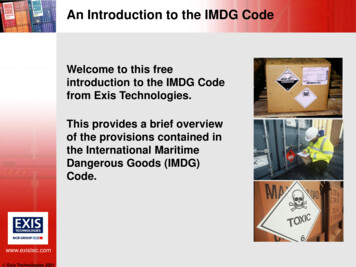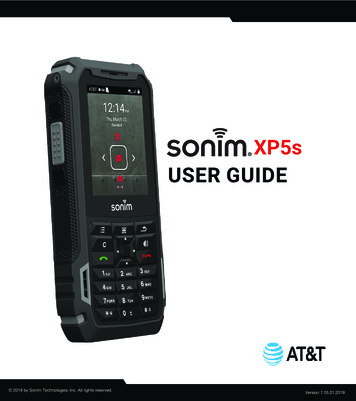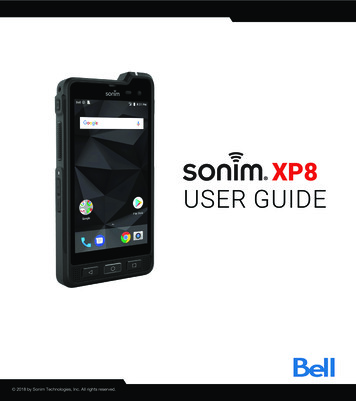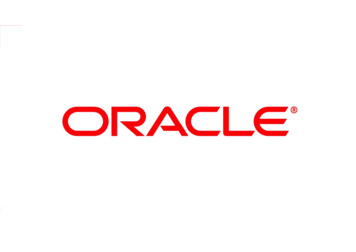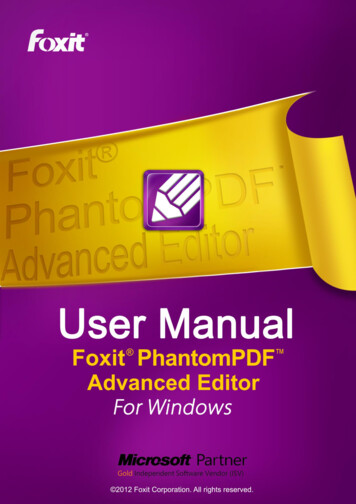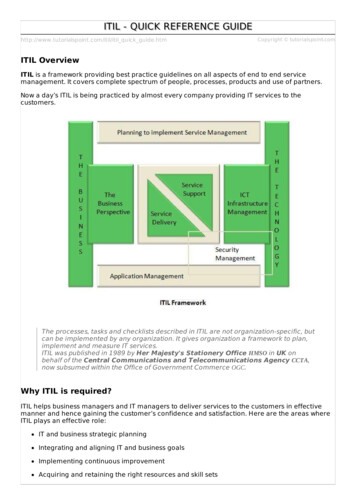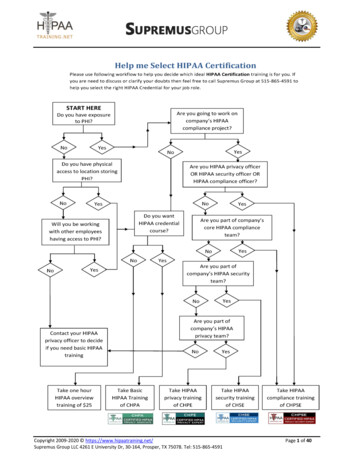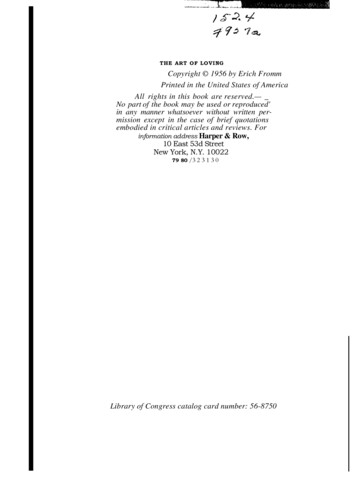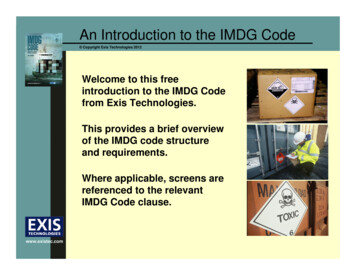
Transcription
An Introduction to the IMDG Code Copyright Exis Technologies 2012Welcome to this freeintroduction to the IMDG Codefrom Exis Technologies.This provides a brief overviewof the IMDG code structureand requirements.Where applicable, screens arereferenced to the relevantIMDG Code clause.www.existec.com
An Introduction to the IMDG Code Copyright Exis Technologies 2012The objective of the International Maritime DangerousGoods (IMDG) Code is to: Enhance the safe transport of dangerous goods Protect the marine environment Facilitate the free unrestricted movement of dangerousgoodswww.existec.com
The International Legal Framework Copyright Exis Technologies 2012The International Maritime Organization (IMO)The IMO is a United Nations specialised agency which hasdeveloped international legislation dealing with two key issues forthe maritime industry: The safety of life at sea Prevention of pollutionfrom shipswww.existec.comIMDG Code reference: 1.1.1
The International Legal Framework Copyright Exis Technologies 2012The International Maritime Organization (IMO)The IMO has developed two international conventions to addressthese issues: The SOLAS Convention (covering safety of life at sea) The MARPOL Convention (covering pollution prevention)To supplement the principles laid down in the SOLAS andMARPOL Conventions, the IMO developed the InternationalMaritime Dangerous Goods (IMDG) Code.The IMDG code contains detailed technical specifications to enabledangerous goods to be transported safely by sea.www.existec.comIMDG Code reference: 1.1.1
Principles of the IMDG Code Copyright Exis Technologies 2012The IMDG Code is based on an internationally agreedsystem which: Groups dangerous goods together based on the hazards theypresent in transport (classification). Contains the dangerous goods in packagings/tanks which are ofappropriate strength and which will prevent the goods escaping. Uses hazard warning labels and other identifying marks to identifydangerous goods in transport. Requires standard documentation to be provided whendangerous goods are being transported. Lays down principles for ensuring that dangerous goods which willreact dangerously together are kept apart. Lays down principles for where to place dangerous goods onboard ship to ensure safe transport.www.existec.com
Principles of the IMDG Code Copyright Exis Technologies 2012Updating the IMDG CodeThe IMDG Code is evolving and is updated every two years to takeaccount of: New dangerous goods which have to be included. New technology and methods of working with or handlingdangerous goods. Safety concerns which arise as a result of experience.Continued www.existec.com
Principles of the IMDG Code Copyright Exis Technologies 2012Updating the IMDG CodeEach version of the Code is given an Amendment number tosignify how many times it has been updated. This number appearsat the bottom of each page together with the year of theAmendment.The current Amendment is 35-10 which will remain in force untilDecember 31st 2013.However, from 1st January 2013 Amendment 36-12 can also beused because 2013 is a transition year which allows the use ofboth Amendments in tandem. You can get a preview of thechanges in Amendment 36-12 by going to:www.imdgsupport.comwww.existec.comLet’s look at this Amendment process further.
Principles of the IMDG Code Copyright Exis Technologies 2012The Amendment Cycle of the IMDG Code Each Amendment is valid for up to three years. There are alternating years for implementation. In January of the yellow years, a new Amendment is published and can be usedimmediately, subject to the timing of National Competent Authority adoption. During the yellow years, the preceding Amendment can also be used, so it is atransition year.www.existec.com In the green years, only the current Amendment may be used.
Layout of the IMDG Code Copyright Exis Technologies 2012The Code comprises 7 parts.It is presented in two books; Volume 1 and Volume 2.It is necessary to use both books to obtain the required information whenshipping dangerous goods by sea.The Code also contains a Supplement.Please note: there will not be a 2012 Edition of the IMDG Code Supplement. Insteadyou will receive a copy of the 2010 Edition plus a two page document of the changesto the 2010 Edition.www.existec.com
Layout of the IMDG Code Copyright Exis Technologies 2012Volume 1 (Parts 1-2 & 4-7 of the Code) comprises:www.existec.comPart 1General provisions, definitions and trainingPart 2ClassificationPart 4Packing and tank provisionsPart 5Consignment proceduresPart 6Provisions for the construction and testing of pressurereceptacles, aerosol dispensers, small receptaclescontaining gas (gas cartridges) and fuel cell cartridgescontaining liquefied flammable gasPart 7Requirements concerning transport operations
Layout of the IMDG Code Copyright Exis Technologies 2012Volume 2 (Part 3 and the Appendices of the Code)comprises:Part 3Dangerous Goods List (DGL), SpecialProvisions Limited and Excepted QuantitiesExceptionsAppendix AList of Generic and N.O.S. (Not OtherwiseSpecified) Proper Shipping NamesAppendix BGlossary of termsAlphabetical Indexwww.existec.com
Layout of the IMDG Code Supplement Copyright Exis Technologies 2012The supplement contains the following texts related to theCode: Emergency Response Procedures for Ships CarryingDangerous Goods Medical First Aid Guide Reporting Procedures IMO/ILO/ECE Guidelines for Packing Cargo TransportUnits Safe Use of Pesticides in Ships, Cargo Holds and CTUs International Code for the Carriage of PackagedIrradiated Nuclear Fuel, Plutonium and High-LevelRadioactive Wastes on Board Shipswww.existec.com
IMDG Code Classification System Copyright Exis Technologies 2012The purpose of the IMDG Code’s classification system is: To distinguish between goods which are consideredto be dangerous for transport and those which arenot. To identify the dangers which are presented bydangerous goods in transport. To ensure that the correct measure are taken toenable these goods to be transported safely withoutrisk to persons or property.www.existec.comIMDG Code reference: 2.0
IMDG Code Classification System Copyright Exis Technologies 2012Dangerous goods are classified into 9 classes according toproperties. The way in which different classes of dangerousgoods are handled in transport will depend upon theseproperties and hazards, for example: The type of packaging that can be used. What classes of dangerous goods can be transportedtogether in freight containers. Where the goods can be stored within the port and on theship.Continued www.existec.comIMDG Code reference: 2.0
IMDG Code Classification System Copyright Exis Technologies 2012The 9 classes:Class 1ExplosivesClass 2GasesClass 3Flammable liquidsClass 4Flammable solidsClass 5Oxidizing substances and organic peroxidesClass 6Toxic and infectious substancesClass 7Radioactive materialClass 8Corrosive substancesClass 9Miscellaneous dangerous substances andarticlesThese 9 hazard classes have been established internationally by a United Nations(UN) committee to ensure that all modes of transport (road, rail, air and sea) classifydangerous goods in the same way.Continued www.existec.comIMDG Code reference: 2.0
Identification of Dangerous Goods Copyright Exis Technologies 2012PSN and UN NumberWithin each of the 9 hazard classes dangerous goods are uniquelyidentified by two pieces of information: A four-digit number known as the UN Number which ispreceded by the letters UN. The corresponding Proper Shipping Name (PSN).For example, kerosene is identified in the IMDG Code by its UNNumber UN 1223 and the PSN Kerosene.Continued www.existec.comIMDG Code reference: 2.0.2
Identification of Dangerous Goods Copyright Exis Technologies 2012PSN and UN NumberTogether the UN Number and PSN uniquely identify dangerousgoods to: enable rapid and precise identification during transport toensure the correct handling, stowage, segregation etc,and in the event of an emergency, ensure that the correctprocedures are followed.www.existec.comIMDG Code reference: 2.0.2
Identification of Dangerous Goods Copyright Exis Technologies 2012Hazard labelsEach of the hazard classes are also identified by labels:www.existec.comIMDG Code reference: 5.2.2.2.2
Understanding the Dangerous Goods List (DGL) Copyright Exis Technologies 2012 The DGL is presented across 2 pages of the IMDG Code and isdivided into 18 columns for each individual dangerousgood listed. Much of the information contained in the DGL is coded tomake it easier to present in a table. The DGL is arranged in UN Number order; column 1 andcolumn 18 contains the UN Number. To look up an entry, you just need the UN Number. However, dangerous goods can also be searched using thePSN. Therefore, if you do not have the UN Number but have thePSN, you can find its associated UN Number by looking atthe alphabetical index at the back of Volume 2.www.existec.comIMDG Code reference: 3.2
Understanding the Dangerous Goods List (DGL) Copyright Exis Technologies 2012Column 1 – UN NumberContains the United Nations Number assigned by the United NationsCommittee of Experts on the Transport of Dangerous Goods (UN List).Column 2 – Proper Shipping Name (PSN)Contains the Proper Shipping Names in upper case characters which maybe followed by additional descriptive text in lower-case characters.Column 3 – Class or DivisionContains the class and, in the case of class 1, the division and compatibilitygroup.Column 4 – Subsidiary Risk(s)Contains the class number(s) of any subsidiary risk(s). This column alsoidentifies if dangerous goods are marine pollutants by showing the letter ‘P’:Continued www.existec.comIMDG Code reference: 3.2
Understanding the Dangerous Goods List (DGL) Copyright Exis Technologies 2012Column 5 – Packing GroupContains the packing group number (i.e. I, II or III) where assigned to thesubstance or article.Column 6 – Special ProvisionsContains a number referring to any special provision(s) indicated in chapter3.3.Column 7a – Limited QuantitiesProvides the maximum quantity per inner packaging.Column 7b – Excepted QuantitiesProvides a code which can be referenced to determine the maximumquantity per inner and outer packaging.Column 8 – Packing InstructionsContains packing instructions for the transport of substances and articles.Continued www.existec.comIMDG Code reference: 3.2
Understanding the Dangerous Goods List (DGL) Copyright Exis Technologies 2012Column 9 – Special Packing ProvisionsContains special packing provisions.Column 10 – IBC Packing InstructionsContains IBC instructions which indicate the type of IBC that can be used forthe transport.Column 11 – IBC Special ProvisionsRefers to special packing provisions applicable to the use of packinginstructions bearing the code ‘IBC’ in 4.1.4.2.Column 12 – IMO Tank InstructionsThis column is no longer used but used to apply to IMO portable tanks androad tank vehicles.Column 13 – UN Tank and Bulk Container InstructionsContains T codes (see 4.2.5.2.6) applicable to the transport of dangerousgoods in portable tanks and road tank vehicles.Continued www.existec.comIMDG Code reference: 3.2
Understanding the Dangerous Goods List (DGL) Copyright Exis Technologies 2012Column 14 – Tank Special ProvisionsContains TP notes (see 4.2.5.3) applicable to the transport of dangerousgoods in portable tanks and road road tank vehicles.Column 15 – EmSRefers to the relevant emergency schedules for FIRE and SPILLAGE in‘The EmS Guide – Emergency Response Procedures for Ships CarryingDangerous Goods’.Column 16 – Stowage and SegregationContains the stowage and segregation provisions as prescribed in part 7.Column 17 – Properties and ObservationsContains properties and observations on the dangerous goods listed.Column 18 – UN NumberContains the United Nations Number for ease of reference across bothpages of the printed book.www.existec.comIMDG Code reference: 3.2
Training Requirements Copyright Exis Technologies 2012In the 2002 edition of the IMDG Code, training was introduced forthe first time.The IMO Member Governments recognised that the safe transportof dangerous goodsby sea is dependent upon theappreciation, by all personsinvolved, of the risks involvedand on a detailed understandingof the IMDG Code requirements.Continued www.existec.comIMDG Code reference: 1.3
Training Requirements Copyright Exis Technologies 2012These training requirements highlight the need for all shore-basedpersonnel involved in the shipment of dangerous goods to receivetraining commensurate with their responsibilities. The IMDG Codedefines shore-based personnel as those who: classify dangerous goods and identify PSNspack dangerous goodsmark, label or placard dangerous goodsload/ unload CTUSprepare transport documents for dangerous goodsoffer dangerous goods for transportaccept dangerous goods for transporthandle dangerous goods in transportprepare dangerous goods loading/stowage plansload/unload dangerous goods into/ from shipscarry dangerous goods in transportenforce, survey or inspect for compliance with applicable rulesand regulationswww.existec.comIMDG Code reference: 1.3
IMDG Code e-learning Copyright Exis Technologies 2012Exis Technologies have developed a computer based IMDG Codee-learning course in collaboration with the International MaritimeOrganization. Designed primarily for shore-based personnel, itallows the user to select training relevant to their specific jobfunctions.Further details on the course are available atwww.imdge-learning.comwww.existec.comExis Technologies also designs Hazcheck Systems for themanagement of dangerous goods in sea transport. Exis has beensetting the dangerous goods compliance benchmark in seatransport for over 25 years.Continued
Hazcheck Systems Copyright Exis Technologies 2012Hazcheck Systems enable every l
Principles of the IMDG Code Updating the IMDG Code Each version of the Code is given an Amendment number to signify how many times it has been updated. This number appears at the bottom of each page together with the year of the Amendment. The current Amendment is 35-10 which will remain in force until December 31 st 2013.
